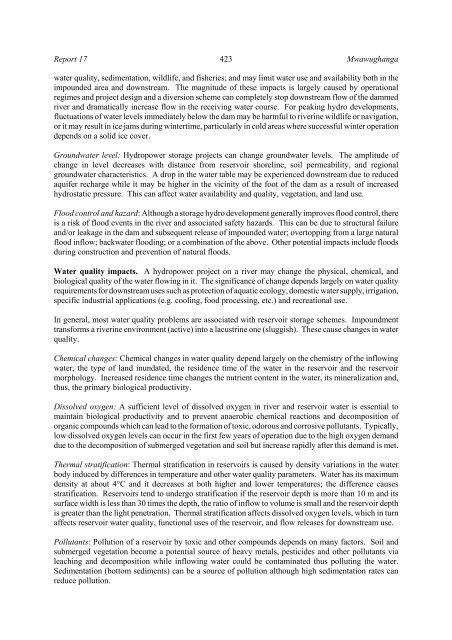comparison of environmental aspects of geothermal ... - Orkustofnun
comparison of environmental aspects of geothermal ... - Orkustofnun
comparison of environmental aspects of geothermal ... - Orkustofnun
You also want an ePaper? Increase the reach of your titles
YUMPU automatically turns print PDFs into web optimized ePapers that Google loves.
Report 17<br />
423<br />
Mwawughanga<br />
water quality, sedimentation, wildlife, and fisheries; and may limit water use and availability both in the<br />
impounded area and downstream. The magnitude <strong>of</strong> these impacts is largely caused by operational<br />
regimes and project design and a diversion scheme can completely stop downstream flow <strong>of</strong> the dammed<br />
river and dramatically increase flow in the receiving water course. For peaking hydro developments,<br />
fluctuations <strong>of</strong> water levels immediately below the dam may be harmful to riverine wildlife or navigation,<br />
or it may result in ice jams during wintertime, particularly in cold areas where successful winter operation<br />
depends on a solid ice cover.<br />
Groundwater level: Hydropower storage projects can change groundwater levels. The amplitude <strong>of</strong><br />
change in level decreases with distance from reservoir shoreline, soil permeability, and regional<br />
groundwater characteristics. A drop in the water table may be experienced downstream due to reduced<br />
aquifer recharge while it may be higher in the vicinity <strong>of</strong> the foot <strong>of</strong> the dam as a result <strong>of</strong> increased<br />
hydrostatic pressure. This can affect water availability and quality, vegetation, and land use.<br />
Flood control and hazard: Although a storage hydro development generally improves flood control, there<br />
is a risk <strong>of</strong> flood events in the river and associated safety hazards. This can be due to structural failure<br />
and/or leakage in the dam and subsequent release <strong>of</strong> impounded water; overtopping from a large natural<br />
flood inflow; backwater flooding; or a combination <strong>of</strong> the above. Other potential impacts include floods<br />
during construction and prevention <strong>of</strong> natural floods.<br />
Water quality impacts. A hydropower project on a river may change the physical, chemical, and<br />
biological quality <strong>of</strong> the water flowing in it. The significance <strong>of</strong> change depends largely on water quality<br />
requirements for downstream uses such as protection <strong>of</strong> aquatic ecology, domestic water supply, irrigation,<br />
specific industrial applications (e.g. cooling, food processing, etc.) and recreational use.<br />
In general, most water quality problems are associated with reservoir storage schemes. Impoundment<br />
transforms a riverine environment (active) into a lacustrine one (sluggish). These cause changes in water<br />
quality.<br />
Chemical changes: Chemical changes in water quality depend largely on the chemistry <strong>of</strong> the inflowing<br />
water, the type <strong>of</strong> land inundated, the residence time <strong>of</strong> the water in the reservoir and the reservoir<br />
morphology. Increased residence time changes the nutrient content in the water, its mineralization and,<br />
thus, the primary biological productivity.<br />
Dissolved oxygen: A sufficient level <strong>of</strong> dissolved oxygen in river and reservoir water is essential to<br />
maintain biological productivity and to prevent anaerobic chemical reactions and decomposition <strong>of</strong><br />
organic compounds which can lead to the formation <strong>of</strong> toxic, odorous and corrosive pollutants. Typically,<br />
low dissolved oxygen levels can occur in the first few years <strong>of</strong> operation due to the high oxygen demand<br />
due to the decomposition <strong>of</strong> submerged vegetation and soil but increase rapidly after this demand is met.<br />
Thermal stratification: Thermal stratification in reservoirs is caused by density variations in the water<br />
body induced by differences in temperature and other water quality parameters. Water has its maximum<br />
density at about 4°C and it decreases at both higher and lower temperatures; the difference causes<br />
stratification. Reservoirs tend to undergo stratification if the reservoir depth is more than 10 m and its<br />
surface width is less than 30 times the depth, the ratio <strong>of</strong> inflow to volume is small and the reservoir depth<br />
is greater than the light penetration. Thermal stratification affects dissolved oxygen levels, which in turn<br />
affects reservoir water quality, functional uses <strong>of</strong> the reservoir, and flow releases for downstream use.<br />
Pollutants: Pollution <strong>of</strong> a reservoir by toxic and other compounds depends on many factors. Soil and<br />
submerged vegetation become a potential source <strong>of</strong> heavy metals, pesticides and other pollutants via<br />
leaching and decomposition while inflowing water could be contaminated thus polluting the water.<br />
Sedimentation (bottom sediments) can be a source <strong>of</strong> pollution although high sedimentation rates can<br />
reduce pollution.

















